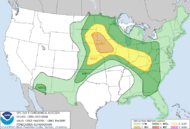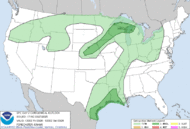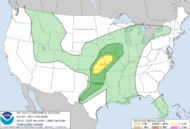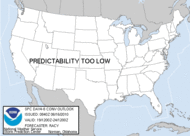Severe weather brings out the best and worst of storm spotters and storm chasers. If you are doing it for notoriety or money, you are probably doing it for the wrong reasons. If your primary motivation is to provide a public service, “ground truth” reports to the media or National Weather Service, advance scientific research, or to explore your fascination and knowledge of weather, you are in it for the right reasons.
During the recent outbreak of tornadoes on the Plains, many photos, videos, forecasts, and comments flooded social media. Most of them were fascinating and useful. However, having chased storms for over 25 years and having been close to some heartbreaking and traumatic experiences, I have lost patience for “chasers” who seem oblivious or callous to how severe weather affects people. It rubs me the wrong way when people seem to get excited and even seem to like the fact a tornado is moving toward a highly populated area. And as bad as that may be, I really don’t understand why they cannot at least keep such feelings to themselves, rather than projecting it publicly through social media.
Personal experiences have made it impossible for me to be oblivious to how severe weather changes people’s lives. One of my best friends’ wife was permanently injured in the F-4 tornado that hit Airport Road in Huntsville November 15, 1989. On May 18, 1995, while chasing, I drove up on damage from the F-4 Anderson Hills tornado at the Oakdale Mobile Home Park near Athens. Every mobile home was destroyed. There were people wandering around and some yelling and screaming for help. I, along with another man, found a man lying on his back. He was bleeding badly from his face down to his abdomen. We carried him out, using someone’s front door as a makeshift stretcher. This was such a traumatic experience. On April 27, 2011, I witnessed the EF-4 tornado that destroyed much of Tuscaloosa, a town I lived in for 8 years. I have been around several tornado-damaged areas over the years. These events were not only heartbreaking, they have cemented in my heart and mind the fact that there is nothing exciting, fun, or gleeful about a tornado that damages property or injures or kills people. On the contrary, I see my number one role as a spotter is to provide information that will help prevent people from being hurt or losing their lives. I am committed to maintaining that as my primary reason for chasing.
Some may ask, what is wrong with making money storm chasing? In and of itself there is nothing wrong with it. We live in a free enterprise system. But the fact of the matter is that there are probably only a handful of people, at the most, who make a living by chasing storms. If you are thinking about getting into it in order to make money, you might as well not even begin. Most chasers make no money at all. Those who do are fortunate if they make enough to cover the expenses of chasing. When you consider the cost of equipment, communications, time off work, and transportation costs, chasing can be an expensive hobby. A few chasers have been able to make back some of those expenses working with media, giving paying passengers chase “tours”, and selling outstanding video to media outlets. I have been fortunate enough to work with media and numerous media outlets have purchased my video. However I was also chasing in the 1980’s when practically no one knew I was out and I did it because I was fascinated with weather, never dreaming I might make a few dollars.
I don’t like to be quick to judge the motives of other people, because it is nearly impossible to know what is in the heart of another person. Sometimes it’s hard enough to judge our own motives. But, I see signs that make it appear that a lot of folks are way too concerned about notoriety. Don’t get me wrong, it is nice to be recognized and appreciated. Whether it is someone I know in another walk of life, a member of the local media or National Weather Service, or people I meet, it is gratifying when people express appreciation or respect for what I do. It just seems that some people go overboard blowing their own horns. I also understand that it is important to get your name out there if you want to reach more people. I am not pointing fingers at anyone specifically, but there can be overkill with the fancy flashing lights, stickers, magnets, signs, tee shirts, and constant bragging on social media. Generally, I think the best approach is to work hard, study, learn, meet others, put the basic information out there, start out with a servant’s heart, build credibility over time (years), and then let your work speak for itself. One way to monitor your motives is if you at least occasionally enjoy chasing “stealth”, meaning going out without telling many people. When I began chasing in the 1980’s, virtually no one knew I was doing it. I still go out some these days without telling anyone so that I can photograph lightning or storm structure or to get a time lapse of clouds. Even if I happen not to have equipment with me, I will be looking out the window to watch the weather.
I do think the life-saving and scientific information provided by storm chasers far outweighs the negatives. So much information has been gained from chasers over the years and it has helped advanced the science of meteorology. The information provided by storm spotters and chasers has also contributed to a warning process that has saved many lives. When a meteorologist with the National Weather Service is told what a trusted, well-trained storm spotter is seeing at a particular time and location, it can have an effect on whether a warning is issued, what kind of warning is issued, whether a warning will continue, or even the wording in a warning. If a trained spotter with a good track record reports a definite tornado, it is powerful and useful information. It is also useful when the same spotter reports there is no tornado at a particular time and location. Even with the advances in RADAR over the years with the advent of NEXRAD velocity products and Dual Polarimetric technology, radars are limited. In addition to reports, photographs and video that spotters and chasers can transmit in real-time can be extremely beneficial. When television stations actually broadcast video of a tornado live, people are more prone to take shelter. These are some of the reasons why trained, experienced, and credible storm chasers are an integral part of the warning process.
I have noticed that there are numerous young people that have shown an interest in storm chasing in recent years, especially since the April 27, 2011 tornado outbreak. This is a great thing! I would like to submit a few “do’s” and “don’ts” for you to consider as you move forward with the hobby. I don’t claim to have always abided by every one of these items perfectly, but it definitely needs to be our goal.
Don’t:
• Drive dangerously, block traffic, or violate traffic laws
• Forget about the dangers of hydroplaning
• Park on the road to shoot video
• Try to get too close to a tornado (err on the side of caution)
• Core punch or drive into areas of large hail
• Drive into tornado damage areas
• Be insensitive to storm victims
• Plan on making a living by storm chasing
• Send in erroneous or exaggerated reports to the NWS or media
• Let your emotions get out of control
• Consider it a failure if you don’t see a tornado
• Expect a constant adrenaline rush. Chasing is mostly a hurry up and wait proposition
• Forget lightning, hail, and flood safety rules
• Chase at night, unless you are particularly experienced and have a plan
• Drive while staring at your phone or laptop
• Chase in metropolitan areas if at all possible
• Drive on mud roads
• Drive under or near a wall cloud
• Get tunnel vision. Keep looking around.
• Park under overpasses.
Do:
• Get all of the storm spotter training you can
• Continue to get training on a regular basis, as long as you chase
• Make sure you are prepared with the best equipment possible
• Spend adequate time looking at data and coming up with a plan of the day
• Be willing to adjust your plan based on radar trends, etc.
• Listen to weather simulcasts, NOAA weather radio, and scanner traffic, as possible.
• Have a reliable chase partner with whom you have good rapport
• Obey traffic laws, including speed
• Respect private property
• Come prepared. Maintain plenty of fuel, drinks, and snacks.
• Allow enough time and get as much rest ahead of time as possible
• Maintain communication with other chasers
• Have someone “on-call” for back-up support
• Remember that traffic accidents and lightning are the main dangers
• Have an escape route. Know the roads.
• Know the geography of your target area well.
• Post chase consider what was done well and what can be learned
• Remember that most of the time chasing is down time
• Remember to report what you see, and where and when you saw it
• Keep your safety and the safety of those around you as your number one priority
Alabama Newscenter — Recipe: Kickin’ Creole Tater Tot Casserole - OK, full disclosure: I’m relatively new to the whole “tater tot casserole” thing. It just wasn’t something that we ever had when I was a kid. But I became ...
1 hour ago









